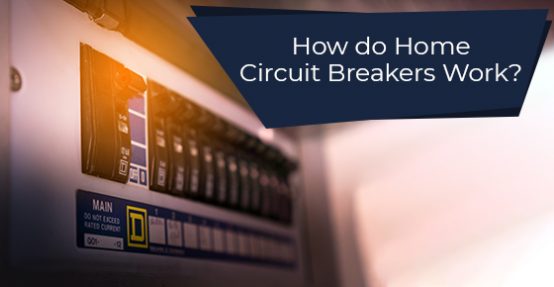
Your home electrical circuit breaker is a critical piece of machinery designed to help safeguard your property. But many property owners don’t know how the electrical circuit breaker works within their home. Our experts have decades of experience in this area of the industry, and in this latest post, we’re exploring how home circuit breakers work.
To truly understand the mechanics of how home circuit breakers operate, you should first learn the various components of electricity and how they work to form the electrical current.
It’s important to note that you cannot change the current, the voltage, or the resistance within an electrical circuit without the change impacting all elements.
You may know that the electricity entering your home comes from the power distribution grid. But let’s look at the details of where that power begins, and how it’s used within the home.
The end of the wiring connected to the power grid is called the hot wire. The end connected to the appliance inside the home is called the neutral wire and the neutral wire is grounded. The power is created at a local power plant and is delivered to your home at a consistent voltage rate (120 to 240 volts). However, because we know that resistance varies inside all homes, the current level varies. Resistance is actually an important part of the operation for many common household electrical items. For example, the filament inside a lightbulb is highly resistant to flowing charge and so the charge has to grow in order to move along a light bulb’s wiring; this growing charge heats up the filament, which causes the light bulb to glow.
Other household appliances also work to act as a resistor to an electrical charge. This means the electrical resistance in the appliance limits how much charge can flow through a circuit. The appliance keeps the current relatively low for safety purposes, as too much charge would heat the wiring within the appliance to unsafe levels, potentially causing a fire within the home.
The resistance within the appliances helps keep the home safe from electrical issues for the vast majority of the time, but in some cases, the hot wire can connect with the neutral wire or to the ground leading to an electrical event. For example, a fan motor within a device can overheat, then melt, causing the hot wire and the neutral wire to fuse together, allowing minimal resistance within the circuit. This then allows the voltage to push a significant charge through the wire, which can lead to a fire.
So now we come to the most important part of this post: the role of the circuit breaker. We know that the voltage being pushed higher than the circuit capacity can cause a fire. A circuit breaker works to cut off the connection when the current rises to unsafe levels.
The most basic form of home electricity protection is a fuse. A fuse is a thin wire enclosed in a casing plugged into the circuit. When the circuit closes, all charge flows through the fuse wire, and the fuse has the same current as any other area within the circuit. The fuse is designed so that when the heat goes above a certain level, it burns up the wire. This then opens up the circuit before the excess current causes any lasting damage.
The only reason that fuses are being replaced as safety devices is they can only be used once. Each time a fuse is blown, it must be replaced. A circuit breaker is designed to operate in the exact same way as a fuse, opening up the circuit if the current rises to unsafe levels. But the breaker can be used again and again to regain control of excess current.
The basic circuit breaker is a simple switch that’s connected to a bimetallic strip or an electromagnet. The breaker features a hot wire that connects to two ends of the switch. When the switch is flipped on, electricity can flow through the bottom terminal through an electromagnet up to the moving contact, past the stationary contact, and then out to the upper terminal.
The electricity then magnetizes the electromagnet, while increasing electric current enhances the electromagnet’s force and a decreasing current lowers its force. If the current jumps to a level that’s unsafe, the electromagnet pulls down a metal lever connected to the switch link. The link then shifts, pulling the moving contact away from the stationary contact to break the circuit.
All of the wiring within your home likely runs through a home circuit panel (fuse panel). An average panel will usually include about 12 circuit breaker switches, which lead to various areas of your home to prevent surges in electricity damaging the wiring. Larger appliances will have their own circuit to ensure demand is met.
Beyond the traditional electromagnetic and bimetallic strip circuit breakers, there are now new options designed to use electronic systems to monitor current levels. For example, you might have heard of a GFCI, which is a ground fault circuit interrupter. These are a type of circuit breaker that, instead of protecting against damage to building wire, protect against accidental electrical shocks.
The GFCI works to constantly measure the current in the circuit’s hot wire and neutral wire; then, if the hot wire connects to ground (for example, if someone touches the hot wire), the GFCI breaks the circuit, preventing an electric shock. However, because the GFCI doesn’t have to wait for the current to climb to unsafe levels before going into effect, the system can respond quicker than a conventional breaker system.
Our experienced team at Hi-Lite Electric is here to help guide you in maintaining your home electrical systems. To learn more about electrical circuit breakers and the value of the latest products, give our team a call today!
© 2023 Licensed Electrical Installation & Service – Hi-Liteelectricinc.ca
All Rights Reserved.
Leave A Comment